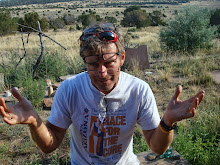Every cyclist has his time, or her time, if one is to be inclusive in
the philosophies of fate. My time came last Sunday as I was descending our
lovely Mount Lemmon Highway, or more specifically, the General Hitchcock Sky
Island Scenic Byway, after turning around at mile marker 20, or about 8,500 feet above sea level.
I was descending with my companions Roger S. and Kathleen K.
when my front tire blew out, suddenly and catastrophically. I “hit the deck,” as
they say, going about 30 miles per hour wearing my skimpy Lycra shorts and my
only slightly less skimpy bike jersey. These wonderful friends stepped in to take care of details like calling 911, getting my bike down the mountain, notifying family.
The resulting abrasions, contusions, hairline fracture, shoulder separation, and edema continue to remind me that I
have lots of nerves in the upper levels of skin, especially on my hip, thigh,
elbow, and shoulder.
In the movie Crash, characters collide with each other as a way of connecting. The LA culturescape, diverse as it is, can be a lonely place where people feel isolated, separated from each other, from nature, and from purpose. Characters look for themselves as they bounce, roll, crunch, collide, and eventually shoot their brethren and sisteren.
The phenomenon of crashing serves as reminder of irrefutable
connection. Physicists and spiritual teachers tell us that we are all
interconnected, whether we recognize it or not. We are all also “activists” in
that our behaviors have effects and consequences on the direction of politics,
economy, the planet, and, who knows?, overall “vibrations.”
So it was my time to enter a worm hole and meet my fate with the road
on Sunday. Going down hard has had a ripple effect on these past few days. For
one, it is painful to move, to resist gravity, to put on a shirt, to get into
the passenger seat so Megan can drive me to work. Every little chore magnifies the physiological complexity of the body and what it needs to do what is necessary.
This second ripple is a wave of wonder and mystery. The intricate miracle of the body hovers right there on the
surface of consciousness. How does it all work? How does a signal from the
brain get translated into my hand picking up a spoon? And why does that hurt so
much?
Then there is the consciousness of connection. This flicker of consciousness that I call “me” is dependent on the body
for its survival. My body is dependent on others for food, for water, for
clothes, housing, language, poetry, music, for bicycles and roads.
I have not done it, whatever that "it" might be, "myself." That is an original error, a lesson learned
somewhere from a spurious commercial or some demagogue of radical
individualism. Some thinkers about this malaise have coined the term "Separation Syndrome," and they see it as the psychological root of apathy, of not caring about anything other that Me-Me. We in the West hold the myth of the lonesome cowboy as sacred, even though it is a fiction, a
construction derived from some fantasy of separateness. Thich Nhat Hahn has it
correct when he writes that the biggest human lesson is to "overcome the
illusion of our separateness."
My usual routine, which is partly an expression of this separateness, has been derailed and complicated by torn ligaments, edema, and stinging
road rash. Being able to see it differently, through a lens of connection (and pain) is a gift, even the dull stuff, and sometimes it takes
being thrown to the road to see it.Pain, wonder, connection, responsibility all lead to an awakening of peace and gratitude.
Thank you elbow for your insistence that I pay attention to you, and to
you hip for sending me notice that scabs are being stretched as I climb
the stairs to teach, and to you shoulder, dull throbbing, that reminds me that
my job is to begin to answer questions that I have not yet learned to ask, questions about where I end and you, dear world, begin, about how your well-being affects mine, about the friends (and enemies) of truth, and when it is time to change a front tire.



No comments:
Post a Comment